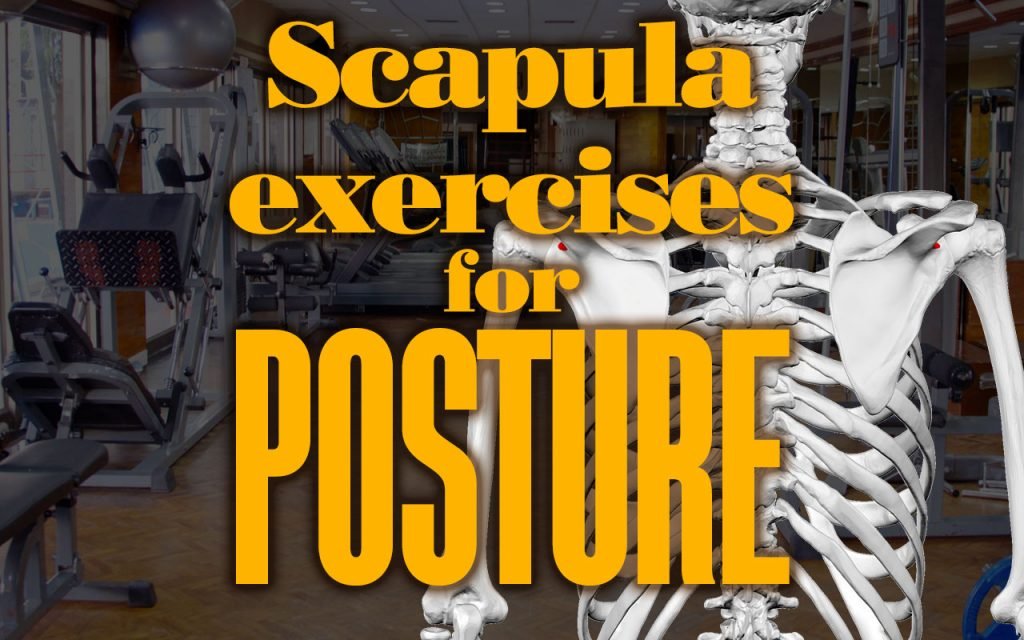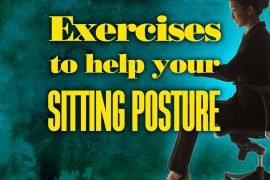[Updated on 1 January 2023] When you hear the word core, the first thing that runs through your mind is abdominal muscles. Its common knowledge that having a strong core equals having good balance, posture and overall strength. But, did you know your shoulders have their core? In this article, we have mentioned few scapula exercises that will make your shoulder, arm & wrist stronger.
Your scapulothoracic joint relies on the coordinated dance of 17 different muscles, as well the mobility at the three other joints, the sternoclavicular, the acromioclavicular, and the glenohumeral joints to provide adequate stability for the rest of the shoulder and arm.
How Does Posture Affect the Scapular?
Table of Contents
 In case you experience any weakness on any other muscles attaching to the shoulder blade, and more so the larger scapular muscles like the latissimus dorsi, serratus anterior, rhomboids, and the trapezius muscles, it could significantly affect the way an individual’s scapula moves and how their shoulder joints work.
In case you experience any weakness on any other muscles attaching to the shoulder blade, and more so the larger scapular muscles like the latissimus dorsi, serratus anterior, rhomboids, and the trapezius muscles, it could significantly affect the way an individual’s scapula moves and how their shoulder joints work.
Your shoulder requires both stability and mobility to support and stabilize the rest of your upper extremity. Having poor movement patterns or deficits in muscle strength at the scapula could lead to pain and injury in the elbow, instability, and uncoordinated movement. It’s important to think of the scapula as the foundation of a building. A building is only as strong as its foundation, just like a tree’s sturdiness is determined by its roots. Similarly, your upper body strength banks heavily on the stability that is provided by your scapular muscles, that ground the upper extremities and allow for greater distal strength.
It doesn’t matter if you play baseball or you are trying to lift your bag in an overhead compartment during a flight, your scapula muscle mobility and strength are key when it comes to preventing injury. In case you have weakness in your shoulder core, or you are not using the stronger, larger muscles that are close to the body, it could lead to the overuse of the smaller muscles found in the extremities. Overuse injuries include golfer’s elbow, also known as medial epicondylitis, tennis elbow, also known as lateral epicondylitis, skier’s thumb, and DeQuervain’s tenosynovitis.
So, how can you improve your shoulder core stronger to protect your hands, wrists, and elbows from injury?
Here are a few exercises that can help improve your scapular stabilization.
Standing Rows
 This exercise will help strengthen your scapular muscles for an improved posture as well as scapular positioning.
This exercise will help strengthen your scapular muscles for an improved posture as well as scapular positioning.
For this exercise, you will need a resistance band. To begin the workout, stand facing an anchor with the resistance band placed at elbow height. Make sure that you are strategically positioned stepping back until your arms are straight, and the resistance band has mild tension. Now, stand tall, bringing your shoulders down and back to engage your abdominal muscles. It is important that you do not hunch your shoulders or push out your ribs.
Draw your elbows back as you squeeze your shoulder blades together behind you. You will soon start to feel the muscles located between the shoulder blades start to activate, and soon, your chest will open up. For this exercise, you will need to perform two sets of 10.
- Targeted back and shoulder muscle activation
- Improves posture and core strength
- Can be done with various equipment options
- It can be easily modified for different fitness levels
- Low-impact exercise, suitable for injury prevention and rehabilitation.
- Strengthens upper back and shoulders
- Improves posture
- Increases core stability
- Can be done with limited space
- Versatile exercise options
- It can be hard on the lower back
- It is difficult for beginners
- Limited muscle activation compared to other exercises
Bilateral External Rotation
 This exercise works to strengthen your rotator cuff muscles.
This exercise works to strengthen your rotator cuff muscles.
For this exercise begin by standing tall with your shoulders down and back drawing your belly in towards your spine. Have your elbows at 90 degrees and the resistance band in your hand, and gently open your arms out to slide against the resistance. It’s important that your shoulders do not tilt forward, keep them down and back. Do two sets of ten repetitions.
- Strengthens rotator cuff muscles
- Improves shoulder stability and mobility
- Can be done with resistance bands or dumbbells
- It can be modified for different fitness levels
- Suitable for injury prevention and rehabilitation of shoulder injuries
- Increases hip joint mobility
- Improves gluteal muscle activation
- Enhances balance and stability
- Reduces risk of a knee injury
- Improves overall lower body strength
- It can be difficult for people with limited hip mobility
- Risk of overuse injury if done excessively
- It can exacerbate existing hip or knee pain
Advanced Plank with Protraction
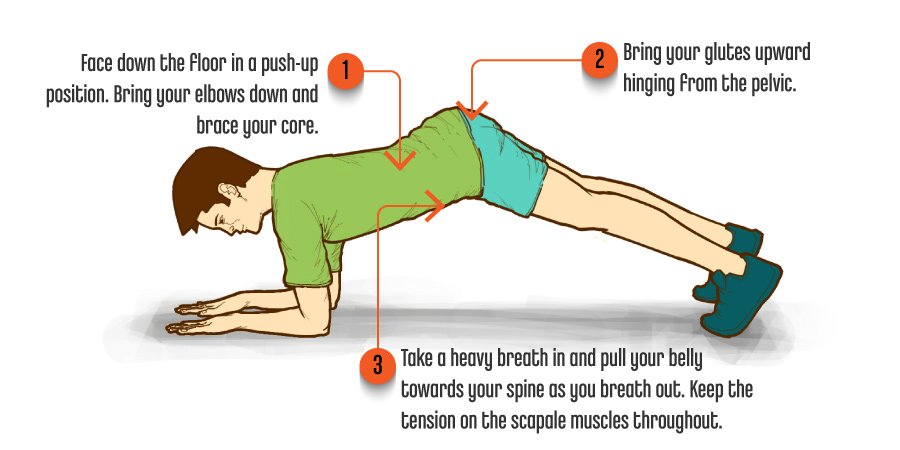 Start this workout in a modified plank-style position making sure that you are resting on the forearms. While still maintaining a neutral spine- pull your belly upwards to your spine for a transverse abdominis muscle meet, activate your serratus anterior by pushing through the forearms, and allowing your shoulder blades to isolate farther away. Now return to the starting position.
Start this workout in a modified plank-style position making sure that you are resting on the forearms. While still maintaining a neutral spine- pull your belly upwards to your spine for a transverse abdominis muscle meet, activate your serratus anterior by pushing through the forearms, and allowing your shoulder blades to isolate farther away. Now return to the starting position.
For this exercise, do ten reps holding for about 3 seconds each time you push your arms away.
- Targets core, shoulder, and back muscles
- Improves posture and stability
- It can be modified for increased difficulty
- Can be performed with or without the added weight
- Great exercise for advanced fitness level and injury prevention
- Strengthens core muscles
- Improves posture
- Increases shoulder stability
- Enhances spinal alignment
- Develops balance and stability
- It may cause back pain
- Requires proper form
- It may be difficult for beginners
ITYWs
 For this exercise, start by laying on the floor in a facedown position, position your arms at sides. it is important that you do not move anything other than your arms. Now, for the “I” with your hands at your hip, palms facing up, thumbs at your thighs, flutter up and down. For the “T” hold your hands out to the sides so that you are creating a “T” with your body. Now, flutter your arms up and down with your palms facing towards the ground. For the “Y,” hold up your arms in a “Y” position and begin to flutter your arms up and down with the palms down. For the “W,” begin from the “Y” position and pull your arms into the body leading with the elbows finishing at the sides to create a “W.” Now, extend both arms forward back to the starting “Y” position and repeat.
For this exercise, start by laying on the floor in a facedown position, position your arms at sides. it is important that you do not move anything other than your arms. Now, for the “I” with your hands at your hip, palms facing up, thumbs at your thighs, flutter up and down. For the “T” hold your hands out to the sides so that you are creating a “T” with your body. Now, flutter your arms up and down with your palms facing towards the ground. For the “Y,” hold up your arms in a “Y” position and begin to flutter your arms up and down with the palms down. For the “W,” begin from the “Y” position and pull your arms into the body leading with the elbows finishing at the sides to create a “W.” Now, extend both arms forward back to the starting “Y” position and repeat.
To have an effective workout, complete two to three sets for 15 seconds each, in all four positions.
- Improves upper back strength and posture
- Increases range of motion in shoulders
- Reduces risk of injury to shoulder blades
- Enhances stability in the scapular region
- Improves overall upper body mobility and function
- Improves cardiovascular health
- Increases muscle strength and flexibility
- Enhances coordination and balance
- Reduces stress and anxiety
- Boosts overall well-being
- Can be time-consuming
- Risk of injury if not performed properly
- Requires proper equipment or gym membership
Scapula Push-Ups
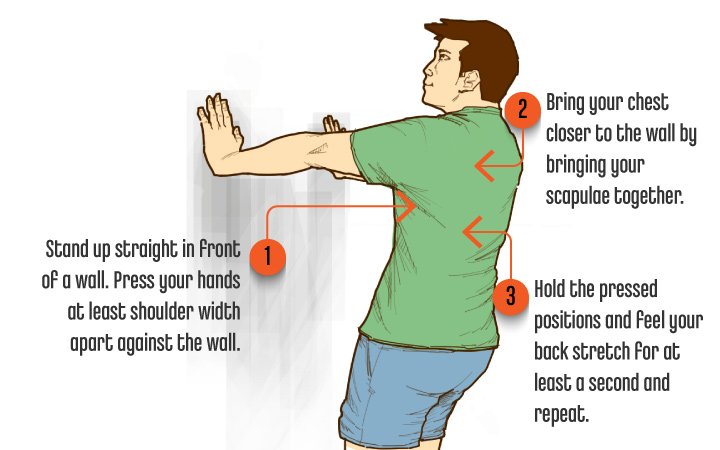 Begin this exercise by standing at a wall with your hands placed at the wall, your chest high and your shoulder-width apart. It’s important that you keep your arms locked out and your palms resting flat on the wall. Now, without bending your arms, reach out using your sternum to the wall until both your shoulder blades come together in the back. Ensuring that you are driving both your hands evenly, shove the sternum away from the wall until both scapulae are open, and the upper part of the back is in a slightly rounded formation. Now, repeat the whole process.
Begin this exercise by standing at a wall with your hands placed at the wall, your chest high and your shoulder-width apart. It’s important that you keep your arms locked out and your palms resting flat on the wall. Now, without bending your arms, reach out using your sternum to the wall until both your shoulder blades come together in the back. Ensuring that you are driving both your hands evenly, shove the sternum away from the wall until both scapulae are open, and the upper part of the back is in a slightly rounded formation. Now, repeat the whole process.
For this exercise, complete two to three sets of 15 to 20 repetitions.
- Target upper back and shoulders muscles
- Increases stability and mobility in the scapula
- Improves posture and alignment
- It can be modified for different fitness levels
- It can be included in a full-body workout routine
- Increased upper body strength
- Better scapula stability
- Improves posture
- Targets smaller muscle groups
- Versatile exercise
- Requires proper form
- Can cause shoulder injury
- Not suitable for beginners
Wall Ball Circles
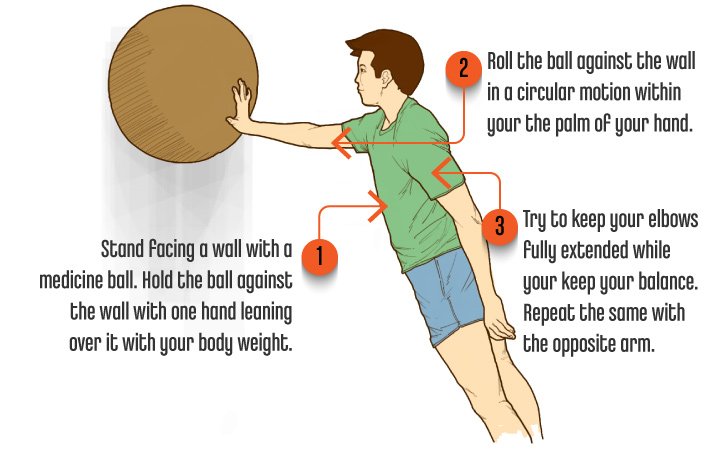 Begin this workout in a standing position facing a flat wall. With your feet shoulder-width apart, extend one hand forward and press a medical ball up against the wall with flat palm about shoulder height off the ground. It is important that you don’t let the ball drop. Now, only using your palm, roll the ball around in small circles, both clockwise and counterclockwise.
Begin this workout in a standing position facing a flat wall. With your feet shoulder-width apart, extend one hand forward and press a medical ball up against the wall with flat palm about shoulder height off the ground. It is important that you don’t let the ball drop. Now, only using your palm, roll the ball around in small circles, both clockwise and counterclockwise.
For this exercise, you will need an 8-pound medicine ball. Do two to three sets and 12 to 15 repetitions on each arm in each direction.
- Targets core and full body
- Improves balance and coordination
- Can be done with a different weight ball
- Works on explosive power and endurance
- It can be used as a warm-up or conditioning exercise
- Improves coordination
- Builds upper body strength
- Increases cardiovascular fitness
- Improves ball control
- Develops eye-hand coordination
- It can be repetitive
- It requires space
- Potential for injury if not done properly
Advanced Stability Ball Push-Ups
 For this exercise, start in a pushup position with both your hands centered on a stability ball and both your feet about hip-width apart on the floor. Bracing your midsection tight, lower your body down so that your chest is touching the ball. On breathing out, steady the stability ball then press back to the starting position.
For this exercise, start in a pushup position with both your hands centered on a stability ball and both your feet about hip-width apart on the floor. Bracing your midsection tight, lower your body down so that your chest is touching the ball. On breathing out, steady the stability ball then press back to the starting position.
For this exercise, do two sets of ten repetitions at bodyweight.
- Increased core engagement for improved stability
- Targeted chest and tricep muscle activation
- Dynamic movement for improved cardiovascular fitness
- Versatile exercise for varying skill levels
- Increased range of motion for a more challenging workout
- Increased core engagement
- Improved balance and stability
- Greater range of motion
- Increased muscle activation
- Enhanced overall workout
- Requires proper form
- It may be difficult for beginners
- Risk of injury if done incorrectly
Prone Raw Scapular Stabilization Exercise
 To perform this exercise, begin by lying on your stomach on a bed. Slide to one section of the bed so that one arm is hanging straight down. Slowly, bend your elbow and then lift your hand towards your armpit. This motion needs to feel like you are pulling on a rope to crank up a lawnmower.
To perform this exercise, begin by lying on your stomach on a bed. Slide to one section of the bed so that one arm is hanging straight down. Slowly, bend your elbow and then lift your hand towards your armpit. This motion needs to feel like you are pulling on a rope to crank up a lawnmower.
Raising your arm, you need to make sure that your shoulder blade is slowly moving back and up. As soon as your hand is almost at your armpit, hold the position for about one or two seconds, and then slowly lower your back down to the starting position. Repeat this motion for a maximum of eight to fifteen repetitions. To increase the intensity, hold a small dumbbell or weight in your hand.
- Enhances postural alignment
- Minimizes risk of a shoulder injury
- Improves scapular stability and control
- Targets shoulder and upper back muscles
- It can be progressed or regressed for different skill levels
- Reduces shoulder pain
- Increases scapular stability
- Enhances shoulder function
- Increases upper body strength
- May aggravate existing injuries
- It can be difficult for beginners
Prone T Scapular Stabilization Exercise
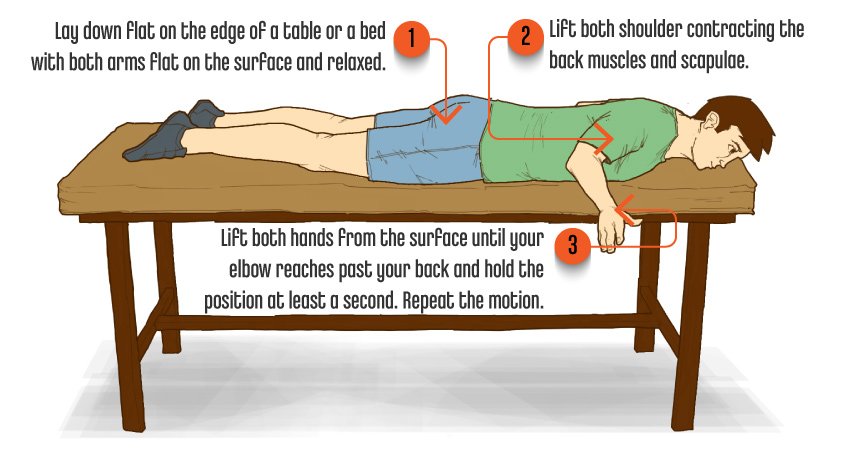 Prone is “to lie with your face down”; therefore, to perform this exercise, you need to lie face down on your stomach at the edge of the bed with one arm hanging straight down toward the floor. If needed, place your opposite hand on your forehead to help support your head.
Prone is “to lie with your face down”; therefore, to perform this exercise, you need to lie face down on your stomach at the edge of the bed with one arm hanging straight down toward the floor. If needed, place your opposite hand on your forehead to help support your head.
With your arms straight, lift it out to the side and pinch your shoulder blade back towards the spine. This needs to feel like one half of the letter “T.” After holding this position for several seconds, return to your initial position, slowly lowering your back.
For this workout, you’ll need to do eight to fifteen repetitions.
- Targeted scapular muscle activation
- Promotes proper shoulder alignment
- Improves posture and core stability
- Decreases risk of a shoulder injury
- Increases upper body strength and endurance
- Improves scapular stability and control
- Increases muscle activation in the upper back
- Enhances posture and alignment
- Reduces risk of a shoulder injury
- It can be easily modified for progression or regression
- May aggravate existing lower back pain
- Requires proper form to avoid improper muscle activation
- It may be difficult for beginners to perform correctly
Prone Y Scapular Stabilization Exercise
 The prone “Y” exercise is similar to the Prone “T” exercise; the only difference is that your arms need to form the letter “Y” during motion. For this exercise, start by lying with your stomach on a bed, ensuring that your arms are hanging down. Now, slowly lift your arm in a diagonal direction so that your shoulder blade pinches you back behind you. Your thumb needs to face up towards the ceiling. It’s important that you feel like one half of the letter “Y” when you are the uppermost position.
The prone “Y” exercise is similar to the Prone “T” exercise; the only difference is that your arms need to form the letter “Y” during motion. For this exercise, start by lying with your stomach on a bed, ensuring that your arms are hanging down. Now, slowly lift your arm in a diagonal direction so that your shoulder blade pinches you back behind you. Your thumb needs to face up towards the ceiling. It’s important that you feel like one half of the letter “Y” when you are the uppermost position.
Hold the “Y” position for one or two seconds, then slowly back down to the starting position and then repeat eight to fifteen repetitions.
- Strengthens scapular muscles
- Improves shoulder mobility
- Enhances posture and spinal alignment
- Reduces risk of a shoulder injury
- Increases upper body strength and stability
- Improves scapular stability
- Enhances shoulder strength
- Improves posture
- Reduces pain/injury risk
- Requires proper form
- Can aggravate an existing injury
- It may not be suitable for all fitness levels
Prone “I” Scapular Stabilization Exercise
 Start the prone “I” exercise in the same position as the T and Y exercise since all of them are scapular exercise. For this workout lie on your belly ensuring that your arm is hanging straight down. Make sure that your elbow is straight and raise your arm overhead. It’s important that your shoulder blade slowly pinches your back when doing this, and your arm needs to be next to your ear at the uppermost position.
Start the prone “I” exercise in the same position as the T and Y exercise since all of them are scapular exercise. For this workout lie on your belly ensuring that your arm is hanging straight down. Make sure that your elbow is straight and raise your arm overhead. It’s important that your shoulder blade slowly pinches your back when doing this, and your arm needs to be next to your ear at the uppermost position.
Now, hold the top position for one to two seconds, and then slowly return your arm to the starting position. It’s important that you repeat this exercise for eight to fifteen repetitions. For increased intensity when you can perform this exercise, hold a small dumbbell in your hand. In case you don’t own a dumbbell, you can use a bottle of water instead. It’s important that you begin with a lightweight, about one or two pounds should be beneficial. Going for a heavier weight could ultimately worsen your shoulder pain.
- Increases range of motion
- Targets specific muscle groups
- Improves coordination and balance
- It can be modified for different fitness levels
- It is performed with or without equipment
- Improves scapular control and stability
- Reduces shoulder pain and injury risk
- Enhances upper body strength and posture
- Facilitates proper muscle activation patterns
- Limited range of motion
- It may be difficult for beginners
- Requires specific equipment or surface
Pulldowns
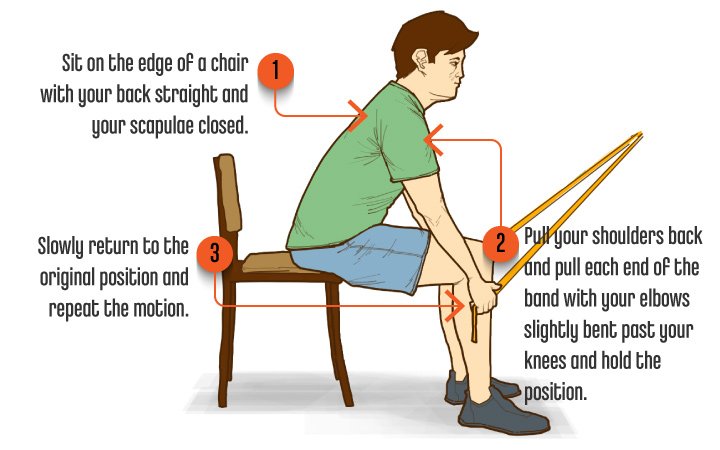 For this exercise, you will require an elastic tubing or band placed on the top of a closed door. To begin, take one end of the band in each hand. This exercise can be performed seated or standing, whichever position you feel comfortable. In case you feel unsteady standing, sit down on a chair. Start your workout with your arms comfortably apart with your elbows straight. It’s important that there is a slight tension in the band or tubing. Now, slightly tuck your chin and face straight ahead.
For this exercise, you will require an elastic tubing or band placed on the top of a closed door. To begin, take one end of the band in each hand. This exercise can be performed seated or standing, whichever position you feel comfortable. In case you feel unsteady standing, sit down on a chair. Start your workout with your arms comfortably apart with your elbows straight. It’s important that there is a slight tension in the band or tubing. Now, slightly tuck your chin and face straight ahead.
With a straight back, calmly pull down and back ensuring that your elbows are bending. Halt when your hands are at par with your chin at a goalpost type of position. Do this motion eight to twelve times.
- Improves upper body posture
- Targets the lats and upper back
- Strengthens the shoulders and biceps
- Increases muscle mass and definition
- Can be done with varying grip types
- Targeted back muscles
- Increased upper body strength
- Improved posture
- Reduced risk of injury
- Limited muscle activation
- Risk of improper form
- Requires equipment access
Chest Goalpost Stretch
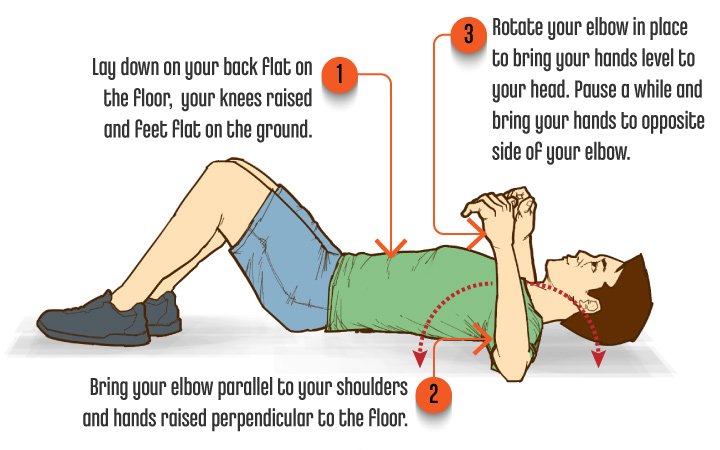 For this exercise, lie on your back. Begin by raising your knees so that they are bent, planting your feet on the floor so that they are hip-width apart. It’s important that you tuck your chin and relax your shoulders. Now, reach your arms straight out to the sides. Slowly bend your arms at the elbows, ensuring your hands are pointed towards the top of your head. It’s important that your arms make an L on the side of your head with your palms facing upwards.
For this exercise, lie on your back. Begin by raising your knees so that they are bent, planting your feet on the floor so that they are hip-width apart. It’s important that you tuck your chin and relax your shoulders. Now, reach your arms straight out to the sides. Slowly bend your arms at the elbows, ensuring your hands are pointed towards the top of your head. It’s important that your arms make an L on the side of your head with your palms facing upwards.
If you do not feel a slight stretch across your chest or in your shoulders, then instead use a tightly rolled blanket or a foam roll under your spine, from your tailbone through to your head. It’s important that you relax in this position for at least 15 to 30 seconds while as you breathe normally. Repeat these two to four times. Do this exercise daily, adding a little more time until you are able to relax in this position for at least two minutes. You only need to do this exercise once per session.
- Stretches upper back and chest muscles
- Enhances range of motion in the shoulders
- It can be modified for different fitness levels
- Helps prevent injury and muscle imbalances
- It can be done as part of a warm-up or cool-down routine
- Increased chest flexibility
- Reduced risk of injury
- Improved upper body movement
- Relief of tension in shoulders and neck
- Limited mobility
- Uncomfortable for some
- May aggravate existing injuries
Shoulder Blade Squeeze
 This is a simple exercise you can perform anywhere, anytime. To start, sit or stand tall with your arms at your side. Keep your shoulders relaxed and down, and make sure they are not shrugged. Now, squeeze your shoulder blades together, and hold for six seconds, then relax. Repeat this motion eight to twelve times.
This is a simple exercise you can perform anywhere, anytime. To start, sit or stand tall with your arms at your side. Keep your shoulders relaxed and down, and make sure they are not shrugged. Now, squeeze your shoulder blades together, and hold for six seconds, then relax. Repeat this motion eight to twelve times.
- It strengthens the upper back muscles
- It can be performed seated or standing
- Isolation of shoulder blades movement
- Helps prevent injury and muscle imbalances
- Improves shoulder blade stability and control
- Strengthens shoulder blades muscles
- Improves posture and alignment
- Reduces upper back pain
- Enhances upper body stability
- Increases shoulder mobility.
- Can cause pain or injury
- Requires proper technique
- It may not be appropriate for certain conditions
Important Features of Scapula Exercise
- Strengthening of the rotator cuff muscles (such as the supraspinatus, infraspinatus, teres minor, and subscapularis) to improve shoulder stability and mobility.
- Targeting the upper, middle, and lower trapezius muscles to improve posture and balance.
- Isolating the serratus anterior muscle to improve scapular control and prevent winging.
- Incorporating exercises that promote scapular stability, such as planks, bird dogs, and wall slides.
- Stretching the pecs, lats, and other muscles that can cause tension and pull on the scapula.
- Incorporating exercises that promote proper scapular movement and positioning, such as rows, pull-ups, and push-ups.
- Progressing the exercises gradually, starting with bodyweight exercises and eventually incorporating resistance bands or weights.
- Incorporating exercises that promote scapular mobility, such as scapular wall slides, banded pull-apart, and threading the needle.
Things To Take Care of While doing Scapula Exercise
When performing scapula exercises, it is important to maintain proper posture and engage the correct muscles. Here are a few things to take care of while doing the Scapula exercise
- Please keep your shoulders back and down, and avoid hunching forward.
- Engage your core muscles to maintain a stable spine.
- Focus on using the muscles in your upper back and shoulders to move your scapula rather than your arms or neck.
- Take your time with the exercises and avoid rushing through them.
- Avoid overusing the same muscles by mixing up your scapula exercises.
- Avoid excessive force or weight, and do not push yourself beyond your limits.
- Consult with a physical therapist or trainer if you have any injury or pain.
- If you experience pain or discomfort during the exercises, stop and consult a healthcare professional.
FAQs
What exercises are best for targeting the scapula?
Some exercises that can help target the scapula include scapular push-ups, scapular retraction exercises, and scapular depression exercises. These exercises can be done with or without resistance, such as using dumbbells or resistance bands.
How often should I perform scapula exercises?
It is recommended to perform scapula exercises 2 to 3 times a week as part of a well-rounded workout routine. It’s essential to listen to your body and not put too much pressure on yourself, especially if you are new to these exercises or have any pre-existing injuries.
Can scapula exercises help with shoulder pain?
Scapula exercises can help alleviate shoulder pain by improving posture and strengthening the muscles that support the shoulder. However, if you are experiencing chronic shoulder pain, it is essential to consult with a medical professional to determine the underlying cause and determine the most appropriate course of treatment.
Is it necessary to use weights when performing scapula exercises?
No, weights are not necessary when performing scapula exercises. You can use your own body weight to perform these exercises. You can use resistance bands, dumbbells, or other equipment to add resistance and increase the challenge of the exercises.
Is there any equipment required for scapula exercises?
Some scapula exercises, such as pull-ups and rows, require equipment such as a pull-up bar or resistance bands. Other exercises, such as planks and bird dogs, can be performed using body weight.
Bottom Line
Having shoulder pain and dysfunction are quite common problems that your physical therapist needs to be able to manage. However, doing Scapular stabilization exercises can be a great way to regain the normal control and use of your arm after experiencing shoulder injury or even surgery. You can perform these exercises a few times a week to regain appropriate strength and postural control of your shoulder to potentially prevent you from future complications.


